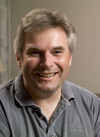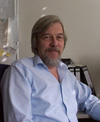 |
|
|
 |
John Womersley, New Head of Particle Physics at RAL
"The LHC will blaze a trail into the TeV scale, but will leave us more questions than answers. The ILC is the right tool to answer many of those open issues." - John Womersley

John Womersley
|
John Womersley started this month as the new Director of Particle Physics at the Rutherford Appleton Lab, which is, (among other things,) the United Kingdom's national high energy physics laboratory. Womersley previously worked at Fermilab and at the Department of Energy in Washington, DC. Womersley says his heart enjoys hadron colliders - the thrill of pushing to the highest energies - but increasingly his head has come to appreciate the beautiful precision that is possible at a lepton collider.
Even from across the Atlantic, he says it is clearly noticeable that the UK is playing a strong role in linear collider R&D. UK physicists are prominent within the Global Design Effort and were very visible at the recent Snowmass meeting. Womersley would like to see the UK take a strong role in the process of getting the ILC approved. The UK has often seen itself as a potential bridge between Europe and North America, and though this idea has been ridiculed often enough, it may well be part of the solution to the political challenge of getting the ILC project going.
"The level of ILC R&D throughout the world has to grow", says Womersley, "if it is to successfully lead to a project of this size. On the other hand, everyone wants to reap the full physics benefits of our large investment in the LHC and there are also exciting new initiatives in other areas, so we have an interesting balancing job ahead of us. We should remember, though, that having a rich menu of excellent physics opportunities is actually a good thing.
--Nicolas Delerue
Read complete interview
|
 |
|
|
 |
Upcoming meetings, conferences, workshops
Nanobeams 2005
Kyoto, Japan, 17-21 October 2005
European GDE Meeting
Oxford, England, 24-25 October 2005
ECFA ILC Workshop
Vienna, Austria, 14-17 November 2005
TESLA Technology Collaboration Meeting
Frascati, Italy, 5-6 December 2005
GDE Meeting
Frascati, Italy, 7-10 December 2005
2006 LCWS 2006
Bangalore, India, 9-15 March 2006
|

Pohang Accelerator Laboratory (PAL) Director In Soo Ko, Korea,
explains the S-band linear accelerator to the participants of the
8th ICFA Seminar on Oct. 1. The laboratory will upgrade its light
source facility with free electron laser to be commissioned in 2010.
Learn more about Pohang Accelerator Laboratory
|
|
 |
 |
|
|
 |
ATF - A Unique Facility for
Nano-beam

ATF is the forefront of the low-emittance and high intensity beam steering technology.
(Photo by Tsunehiko Omori)
|
Traditional circular accelerators around , like LEP and KEKB, accelerate electrons and positrons in rings into opposite directions respectively. A bunch of electrons and another bunch of positrons encounter each other many times in a ring, and consequently have many chances to collide.
In the ILC on the other hand, electrons and positrons are accelerated oppositely, meeting only once at the collision point. No consolation match is allowed.
Solution? Squeeze the size of the electron- and positron-bunches as much as possible, down to the nanometer level. This increases the chance for electrons and positrons in each bunch to collide at the interaction point. But this is easier said than done. At KEKB, electrons and positrons are colliding at the world record luminosity in bunches that are a few micrometers, the thickness of a single strand of hair.
For the ILC, we need to squeeze the beam bunches to even thinner ones, a few nanometer. Think about shooting down a bird in the sky. Now you need to aim for a thousand times smaller target, such as a pinhead at the same distance.
To study the technical challenges of ultra-narrow "beam-size", or "emittance" in the technical terms, Accelerator Test Facility (ATF) was constructed in 1997 at KEK. In this facility, electron-beams are accelerated by the S-band micro-cavity linac to the energy of 1.3 GeV. The beam is then injected into a "race track"-shape damping ring. There, electron-beams are "cooled down" into nanometer size. ATF has achieved the lowest emittance of 4 pmrad in 2001, the world-champion record of small electron-beam size.
ATF has become a unique facility to provide a test-bed for low-emittance beam control. Many accelerator physicists around the world gather into ATF and test the performance of their apparatus in make-shift operations.
"This facility is unique for the demonstration of beam-orbit control with the resolution of a few nanometers", says Professor Urakawa, the project manager of ATF, "and for the demonstration of long-term stabilization with beams of several-tens nanometers, and as the place to train young physicists for ILC commissioning."
--Youhei Morita and Kaoruko Saeki
|
 |
|
|
 |
From Argonne National Laboratory,
4 October 2005
MSU professor to lead high-energy physics programs at Argonne
ARGONNE, Ill. (Oct. 4, 2005) – Hendrik (Harry) J. M. Weerts has been named director of the High Energy Physics Division at the U.S. Department of Energy's Argonne National Laboratory.
Read more
From Physics Web,
27 September 2005
New look for laser accelerators
Physicists in the US have developed a new type of laser-based particle accelerator. Tomas Plettner and co-workers at Stanford University and the Stanford Linear Accelerator (SLAC) used a commercial laser operating at a wavelength of 800 nm to modulate the energy of electrons travelling in a vacuum. The modulation they achieved was equivalent to an electric field gradient of 40 million volts per metre. The technique could be used to accelerate particles into the TeV energy range in the future (Phys. Rev. Lett. 95 134801).
Read more
|
|
 |
 |
|
|
 |
Parameters for the Linear Collider
The main goal of the GDE this fall is to determine a baseline configuration for the ILC. This baseline will serve as the basis for the reference design process that we will carry out next year. I plan to describe our process and outline some of the key issues that we must decide in this weekly column during the coming months, while we are defining our baseline configuration.
In general, the design of a large complex project should "flow down" from a set of performance and technical requirements. Fortunately, we have such a set of parameters for the ILC that are contained in a report dated September 30, 2003 and entitled, "Parameters for the Linear Collider." This document is the report of a subcommittee appointed by the International Linear Collider Steering Committee (ILCSC), which also serves as the parent body for the GDE.

Rolf Heuer
|
The parameter group who created this report consisted of Sachio Komamiya and Dongchul Son from Asia, Rolf Heuer (chair) and Francois Richard from Europe, and Paul Grannis and Mark Oreglia from North America.
This concise and well written document nicely lays out a set of basic parameters with values for the ILC. Although this study should probably be updated at some point, the published set of parameters is based on a broad review of the anticipated physics program for the linear collider, and the basic science goals have not changed.
Some of the key parameters that define the baseline include the energy range (200 – 500 GeV); the luminosity and reliability enabling the collection of approximately 500 fb-1 of science data in the first four years of running after commissioning; energy scans at all centre-of-mass energy values between 200 GeV and 500 GeV with less than 10% loss in data taking; beam energy stability and precision below 0.1 %, in the continuum as well as during energy scans; the capability to produce electron beams with polarization of at least 80%; and the upgradeability to 1 TeV.
Read more
--Barry Barish
Director's Corner Archive
|
 |
|
|
 |
SMTF Collaboration Meeting
The SMTF Collaboration Meeting is taking place at Fermilab 5-7 October. An
agenda and talks are available online.
New ILC Members?
Does your group have new members working on ILC-related R&D? Did new
graduate students join your Institute? Let the GDE Communicators know when new
collaborators join the ILC R&D, and we will announce it in ILC NewsLine.
ILC Related Preprints
No new preprints were found this week. If you recently released a preprint related to the ILC, let us know!
European GDE Meeting
The European GDE members will meet at Oxford University, England,
24-25 October 2005 to discuss matters of specifically European
interest, in particular optimisation of R&D and preparation for
further bids to the EU and elsewhere, and outreach. There will
be a dinner on the night of 24 October. Accommodations can
be arranged in Oxford, either in a hotel or a guest room in a college.
The meeting is intended for European GDE members, but all GDE members
are invited to attend. If you would like to attend, respond to
Brian Foster
and Sue Geddes by October 10.
|
|

